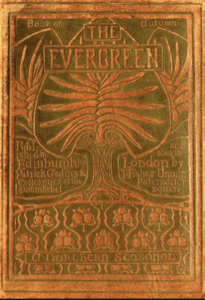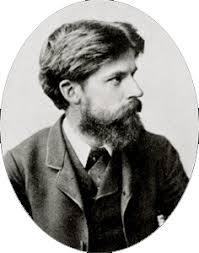Cultural Progression as A Result of The Unification Between Art and Science in Patrick Geddes’ “Life and Its Sciences”.
© Copyright 2019 Emily Scaglione, Ryerson University
Introduction
The Evergreen: A Northern Seasonal is a four-part magazine series that was published by Patrick Geddes and colleagues in London between 1895 and 1897. Each volume that was created represented a season, there were four volumes in total. These volumes usually dealt with themes that came with each season, and with that, there was also quite a bit of scientific background that tied into each of these volumes.

Patrick Geddes’ Life and Its Sciences can be found in Volume one of The Evergreen, also commonly titled The Spring Edition. The article, or essay in other terms, that he provided for this volume was based on most of his findings as a Biologist, Sociologist. Most of his ideas that he brings up within his writing is well cemented in the development of humans, and cultural progression. People who might read this article might draw different conclusions, saying that the article is neither about Science or Life, but it is about the environment, some say that it is a cry for help, saying that it might be too late if we don’t start caring about the environment. If you look further into the reading though, there is an underlying subject that arises.
The comparison and the acknowledgement of Science being fairly similar to Art are brought up in the subject matter. Partick Geddes seems to provide the idea that without Art there would be no Science, and without Science, there would be no art, because Artists and Scientists have similar abilities to observe life in different situations. There is an issue that arises within this essay and that is the division between Art and Science, Geddes believes that if there is this division, there is no way that our Culture could progress because Art and Science rely on each other.

The tone is conversational, and his argument is well rounded, taking most of his knowledge from other subject areas and applying it to the essay. What he writes sometimes goes all over the place, but he leaves room for interpretation, something that is rarely given in these sorts of essays/articles since they are used to prove a point. The subject matter is also open for interpretation as well, judging by what lens you use when you read his writing, the topics he discusses are fairly complicated, and rich in information that is open for debate.
Patrick Geddes and His Contributions Toward Science and The Evergreen.
Sir Patrick Geddes was a Scottish Biologist and Sociologist, with an extensive background of knowledge in several other subjects such as; Geography, Philanthropy, and Urban Planning, which was what he was known for the most out of all of the prior contributions that he had made to the world around him. Geddes was a well-rounded person, that mixed several general topics together, to further develop his research. He was very interested in the development of humans, Darwinism, and Charles Darwin himself was a very poignant part of Geddes’ research into human life and Cultural Progression.

Geddes also had an evolutionary development theory, from which he developed from a Social theorist by the name of Herbert Spencer, he thought that the concept of Biological evolution could be applied to expand and explain the evolution of society. He used this theory and applied it to his Urban Planning journey, but it also helped him form his opinions on how we as a Culture develop and progress over time, with certain aspects of life that generally fly under the radar. In addition to his work within Urban Planning and Biology, he also published the first volume of The Evergreen, in 1895, which was where he poured his thoughts into the volume, under Life and Its Sciences.
His knowledge is rich, and there is a lot of information that he is able to provide within his writings, especially when it comes to proving his points, or backing up his theories. His interests and his studies were the main things that developed his views, and it was the one thing that he was able to use to create a broader conversation. This writing piece, in particular, is quite groundbreaking, and it creates a wavelength of conversation and understanding about humans, and how they have developed over time since he had released Life and Its Sciences.
Science and Culture
Mainly Science and Culture are the main things that go hand in hand. We are human beings, we live in this culture, and as human beings, we have been able to develop a culture that is at a constant change. Biological and Cultural evolution has been the main staple that scientists have strived to find answers about. As mentioned before Geddes had a certain interest in Charles Darwin, and Darwin was someone that had quite an interest in humans, and how we have developed throughout time, and how we have grown from our Caveman/Cavewoman ancestors.
As human beings, we also strive for that development, which is something that is built into us, fight or flight if we are being specific. Scientists also use the factor of observing human life to actually be able to get the answers as to why we are always in constant need of change and why we are constantly striving for our society to become furtherly developed in a sense. Geddes uses this concept of wanting change and applies it towards his conversation towards art, and how the mixture of the two fairly similar topics creates a stable development throughout society, and cultural evolution as well.
Similarities Between Art and Science
The similarities to art and science are the fact that they use the same research methods, mostly it’s based on observation, biology is the study of life, something that artists; photographers, painters, even urban planners study. There is a specific way that they do this, they pay the most attention to how people live, interact with each other, and develop together. One of the main reasons as to why, art would need science, and science would need art would be the sheer fact that they already support each other, yet as a society, there was little to no knowledge of this comparison.
We need art and science to be together or else we won’t develop further as a society, that is what Patrick Gedde’s is getting at in his paper that he wrote for The Evergreen. He talks all about Biology, and different sections of science but the fact of the matter is, it is only a cover-up for what he is truly trying to talk about. Cultural Evolution would not exist if science and art did not coincide with each other, we wouldn’t have any sort of educational institutions, there wouldn’t be courtrooms that work well. These things might exist, but it would have been a completely different concept.
Within our current society, we have very evident examples as to how art and science are able to develop and create a standard of Cultural Evolution and development. For example, cell-phones were made with the conversation between an artist and a scientist in mind, if they did not come together and communicate with one another, the cellphone, computer, or television would not have come to be.
The Bigger Picture
So what? Why is this important? Why do art and science have to be together for Cultural evolution, and why does Patrick Geddes say this, and how does he say this? Geddes points out the unity of the methods that artists and scientists use when in the field, when they are researching, and developing their research. He states that if there wasn’t the unification between these two subjects then there wouldn’t be these large, human developments that we have gone through as a society. There would not be cultural movements, and our culture, in general, would stay stagnant, if there wasn’t that unity.
If the scientist no longer looks at the world as an artist would then he would run out of things to research and it goes back to the argument that the author makes about universities and these groups and collective of people that spawn these different groups of study because they got together and shared their ideas with one another. It led to hygiene, medicine, doctors, engineers because they shared each other’s knowledge. This is what Partick Geddes was getting at when he reflects on Cultural Evolution and human development.
Much like the scientist, the scientist needs to see the world through an artist’s eyes and that goes back to the changing of seasons the beauty in the changing of the seasons, being able to look at the world like a Biologist, not like a necrologist, who only observes the dead as mentioned in the article. You need to be able to observe and understand the living because in the living there is art, you need to find things to actually apply the scientific method to and to do that the scientist must be an artist. Drawing from Geddes’ text specifically, there is a correlation that he makes, and he describes it more of something that works together. Art and Science is the main thing that draws everything together, and it is one of the only things that can be brought together, even though it may not be similar in any way, to create new things.
Conclusion
All in all, Patrick Geddes’ research and his essay was created to spark interest in how these non-similar, or at least to the naked eye they are non-similar, things come together, and how it has actually been a staple of Cultural Evolution. If there wasn’t Science or Art, if they were not able to actually come together, we would not have the things that we have today. There would be no technology, no state of the art cars that could drive by themselves. There wouldn’t be Universities, or medical supplies to treat sicknesses, there would be absolutely no way that humans would’ve been able to come this far if there wasn’t a collaboration between, art and science. Without the ability to create, or observe, we would not have enough knowledge to truly help, or have solutions for these situations. The unity of the two is what brings everything together, you can’t just see art as an art, or science as a science, there are artistic aspects of science and scientific aspects of art, they’re not separate ideas, they’re the same, they’re together, and that is what leads to culture evolving, that’s what leads to society progressing.
Works Cited
Geddes, Patrick E. “Life and Its Sciences.” The Evergreen, 1895, Vol. 1, pp. 28-37.
https://www-jstor-org.ezproxy.lib.ryerson.ca/stable/40540095?pq-origsite=summon&seq=1#metadata_info_tab_contents (Guillemin, Roger)
Mitrečić, Dinko, and Franco Rustichelli. “Science and art in the 21st century: on a way toward the unification.” Croatian medical journal vol. 55,5 (2014): 542-4. doi:10.3325/cmj.2014.55.542
Morris, Charles W. “Science, Art and Technology.” The Kenyon Review, vol. 1, no. 4, 1939, pp. 409–423. JSTOR, www.jstor.org/stable/4332109.
Richmond, Sheldon. “The Interaction of Art and Science.” Leonardo, vol. 17, no. 2, 1984, pp. 81–86. JSTOR, www.jstor.org/stable/1574993.
Weihe, Logan, “Thoughts on Similarities Between Artists and Scientists and the Benefits of Studying Visual Art in the Healthcare
Field” (2017). Honors College Theses. 10.
https://digitalcommons.murraystate.edu/honorstheses/10
https://www.embopress.org/doi/abs/10.15252/embr.201847061 (Zhu. Lian, Goyal Yogesh)
